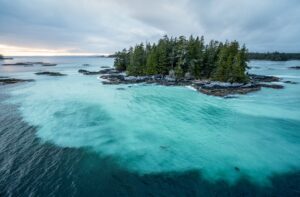It is always a privilege to hear someone talk about something they are a) very knowledgeable about, and b) very passionate about. Norm hit both of these out of the park on Thursday evening at our packed night celebrating paddling in Howe Sound with Blackfish Paddles, which we summarise below in case you couldn’t make it.
The evening started off with David Smart, owner of Blackfish Paddles, giving a bit of history and info about the Squamish company and introducing the two films that they helped produce about paddleboarding, featuring local paddlers – Wild Coast, and Push. If you missed them, you can check out Wild Coast here, and Push here.

The evening about paddling in Howe Sound, and Norm began his talk with a bit of history about the Salish Sea which includes Howe Sound, and the First Nations presence there which goes back at least 13,000 years. There are now 8 million people living near the Salish Sea, and the impact that the population increase, as well as the pollution from industry, has had on the water has been devastating, with fish decimated and larger predators becoming scarce.

Thanks to some stricter regulations, particularly since the 1970s, the pollution going into the water has been more controlled, and wildlife is only now beginning to return to the area in droves. Norm credits much of the return to the rejuvenation of the herring populations which are being welcomed back into the area with open arms…and open mouths. This shot of what looks like a tropical island actually shows the herring spawn around a coastal island on the central coast of BC – a fantastic diet for wolves, bears and seals in the area.

With the return of the herring, there have been huge colonies of Steller sea lions seen in Howe Sound this year. Two years ago there were none seen at all, last year there were 2-3 sightings, and this year there are more than a hundred! This is mostly due to those herring; the biggest run since before the heavy industry of Britannia Mine and the Woodfibre Pulp Mill came to the area.
Along with the sea lions there are now white-sided dolphins, orcas, and even a humpback whale being seen in the area. The fantastic thing about all these megafauna, apart from being an awesome sight for us, is that it is a definite sign of a more healthy ecosystem.

Norm also advocated for spending some time on the Sea to Sky Marine Trail, and the Salish Sea Trail, both of which have campgrounds just waiting for you to paddle to and spend some time at. In Indian Arm you have the awe-inspiring Granite Falls to camp next to – in fact, Norm described the feeling of entering the fjords akin to feeling like entering cathedrals, open to the sky which I think is probably the best description I have heard of what it feels like to be surrounded by such affecting scenery. One great way of getting to know the area is to join Norm on one of his Expeditions, or joining the Coastal Stoke program. Led by Norm or his team, these are fantastic opportunities to explore the area with an expert.
To end, Norm told us that there are apparently two names that the Squamish Nation have for Howe Sound – Atl’Kitsem which means Paddle Up the Sound; and Texnewets, which means Paddle Down the Sound. Whichever direction you paddle the Sound, take time to look around and take it all in. While industry has been curbed for now, the ominous shadow of the Kinder Morgan pipeline in Burrard Inlet and the LNG plant in Howe Sound could take us backwards instead of forwards, and mean that wildlife sightings like these become a rarity.

